6.2Binomial Probability Distribution
 This page includes Video Technology Manuals
This page includes Video Technology ManualsOBJECTIVES By the end of this section, I will be able to …
- Explain what constitutes a binomial experiment.
- Compute probabilities using the binomial probability formula, binomial tables, and technology.
- Calculate the mean, variance, and standard deviation of the binomial random variable and find the mode of the distribution.
1Binomial Experiment
Many different types of discrete probability distributions are used. Perhaps the most important is the binomial distribution, which we will learn about in this section. Life is full of situations where there are only two possible outcomes to a process.
- A baby is about to be born. Will it be a boy or a girl?
- A basketball player is about to attempt a free throw. Will she make it or miss?
- A friend of yours is also taking statistics. Will he pass or fail?
Because situations for which there are only two possible outcomes are so widespread, methods have been developed to make it more convenient to analyze them. These methods begin with the definition of a binomial experiment.
Binomial Experiment
A probability experiment that satisfies the following four requirements is said to be a binomial experiment:
- Each trial of the experiment has only two possible mutually exclusive outcomes (or is defined in such a way that the number of outcomes is reduced to two). One outcome is denoted a success and the other a failure.
- A fixed number of trials exists, which is known in advance of the experiment.
- The experimental outcomes are independent of each other.
- The probability of observing a success remains the same from trial to trial.
Many experiments having more than two outcomes can often be defined so that only two outcomes are possible. For example, the answer to a multiple-choice question that has five answer choices may be recorded as either correct or incorrect.
Let's take a moment to discuss what these requirements really mean.
- A success denotes simply the outcome in which we are interested, without necessarily implying that the outcome is desirable. For example, for a researcher investigating college dropout rates, a dropout would be considered a success in the context of a binomial experiment.
- Tossing a coin 10 times is a binomial experiment because we know the fixed number of trials. A salesman contacting customers one-by-one until he makes a sale is not a binomial experiment because he doesn't know how many customers he will have to contact.
- Sampling without replacement would technically violate the independence requirement. However, recall that we may apply the 1% Guideline from Section 5.3, so that when the sample is small compared to the population, successive trials can be considered independent.
- Suppose four friends are wondering how many of them will get an A in statistics. This is not a binomial experiment because the four friends presumably do not all have the same probability of success.
The outcomes of a binomial experiment, together with their probabilities, generate a special discrete probability distribution called the binomial probability distribution. For binomial probability distributions, only two outcomes are always possible, and each outcome has a probability associated with it. The binomial random variable, denoted by X, represents the number of successes observed in the n trials. Note that 0≤X≤n.
EXAMPLE 14Recognizing binomial experiments
Determine whether each of the following experiments fulfills the conditions for a binomial experiment. If the experiment is binomial, identify the random variable X, the number of trials, the probability of success, and the probability of failure. If the experiment is not binomial, explain why not.
- A fisherman is going fishing and will continue to fish until he catches a rainbow trout.
- We flip a fair coin three times and observe the number of heads.
- A market researcher at a shopping mall is asking consumers whether they use Fib detergent. She asks a sample of four men, one of whom is clearly the employer of the other three.
- The National Burglar and Fire Alarm Association reports that 34% of burglars get in through the front door. A random sample of 36 burglaries is taken, and the number of entries through the front door is noted.
Solution
- This is not a binomial experiment because you don't know how many fish he will catch before the rainbow trout shows up, so a fixed number of trials isn't known in advance.
This is a binomial experiment because it fulfills the requirements:
- Only two possible outcomes are possible on each trial, with heads defined as success and tails as failure.
- We know in advance that we are tossing the coin three times.
- The coin doesn't remember its result from toss to toss, and so the trials are independent.
- The coin is fair on each toss, and so the probability of observing heads is the same on each toss.
The binomial random variable X is the number of heads observed on the three trials; because the coin is fair, the probability of success is 0.5 and the probability of failure is 0.5. The possible values for X are 0, 1, 2, or 3.
- This is not a binomial experiment because the responses are not independent. The response given by the employer is likely to affect the employees' responses.
This is a binomial experiment because it fulfills the requirements:
- Only two possible outcomes are possible on each trial: entering through the front door or not entering through the front door.
- We know in advance that the size of the random sample is 36 burglaries.
- The sample is random, so the trials are independent.
- The sample is quite small compared to the size of the population, so the probability of entering through the front door remains the same from burglary to burglary.
The binomial random variable X is the number of front-door-entry burglaries noted for the 36 break-ins; the probability of success is 0.34 and the probability of failure is 1−0.34=0.66.
NOW YOU CAN DO
Exercises 5–14.
Table 7 gives some notation regarding binomial experiments and the binomial distribution.
| Symbol | Meaning |
|---|---|
| S | The outcome denoted as a success |
| F | The outcome denoted as a failure |
| P(success)=P(S)=p | The probability of observing a success |
| P(failure)=P(F)=1−p=q | The probability of observing a failure |
| n | The number of trials |
Using this notation in the experiment in Example 14(d), we have S = burglary through front door (P(S)=p=0.34), and F = burglary not through front door (P(F)=1−p=1−0.34=0.66=q).
Note: In Section 5.4, we used nCr to indicate the number of combinations. Now that we have learned about random variables, which can be denoted X, we use nCX to represent the number of combinations.
2Computing Binomial Probabilities
We demonstrate three ways of computing binomial probabilities: (a) the binomial probability formula, (b) binomial tables, and (c) technology. Before we examine the binomial probability distribution formula, let us recall from Section 5.4 (page 296) the formula for the number of combinations.
Note: You may find the following special combinations useful. For any integer n:
nCn=1nC0=1nC1=nnCn−1=n
The number of combinations of X items chosen from n different items is given by
nCX=n!X!(n−X)!
where n! represents n factorial, which equals n(n−1)(n−2)…(2)(1), and 0! is defined to be 1.
We are often interested in finding probabilities associated with a binomial experiment.
EXAMPLE 15Constructing a binomial probability distribution

A recent study reported that about 40% of online dating survey respondents are “hoping to start a long-term relationship” (LTR).2 Consider the experiment of choosing three online daters at random, and let
X=the number of "LTRers"
so that a success is defined as choosing someone hoping to start a long-term relationship.
- Construct a tree diagram for this experiment.
- Suppose that we are interested in finding the probability that exactly two of the three online daters would be LTRers, P(X=2). In the tree diagram, highlight in blue the outcomes where exactly two of the three online daters are LTRers. Find the probability for each outcome, and use these to find P(X=2).
- Suppose that we are interested in finding P(X=1). In the tree diagram, highlight in red the outcomes where exactly one of the three online daters is an LTRer. Find the probability for each outcome, and use these to find P(X=1).
Solution
- Figure 7 shows the tree diagram for this experiment.
As we can see from Figure 7, there are (nCx)=(3C2)=3 different ways that exactly two of the three online daters could be LTRers (highlighted in blue).
FIGURE 7 Tree diagram and binomial probabilities. Page 330
Page 330For each of these three outcomes, the probability that X=2 is (0.4)2(0.6)=0.096.
- The outcome S,S,F (second row in Figure 7) has probability (p)(p)(q)=(0.4)(0.4)(0.6)=0.096.
- The outcome S,F,S has probability (p)(q)(p)=(0.4)(0.6)(0.4)=0.096.
- The outcome F,S,S has probability (q)(p)(p)=(0.6)(0.4)(0.4)=0.096.
Note that each of these products equals (p)2.q, with p having exponent X=2, and (q) having exponent n−X=3−2=1. Thus,
P(X=2)=(3C2)(0.4)2(0.6) =3(0.096)=0.288
Similarly, suppose that we are interested in whether exactly one (X=1) of the three online daters is an LTRer. Then, Figure 7 shows us, highlighted in red, that there are (nCX)=(3C1)=3 different ways this could happen. Each of these outcomes has probability (p)⋅(q)2=(0.4)(0.6)2=0.144, where p has exponent X=1, and q has exponent n−X=3−1=2. Thus,
P(X=1)=(3C1)(0.4)(0.6)2 =3(0.144)=0.432
We can generalize these procedures and use the binomial probability distribution formula to find probabilities for the number of successes for any binomial experiment.
Remember: P(S)=p and P(F)=q
The Binomial Probability Distribution Formula
The probability of observing exactly X successes in n trials of a binomial experiment is
P(X)=(nCX)pX(q)n−X
That is,
P(X)=(nCX)[P(success)number of successes⋅P(failure)number of failures].
We often call this the binomial probability formula.
Steps for Solving Binomial Probability Problems
To solve a binomial probability distribution problem, follow these steps:
- Step 1 Find the number of trials n, and the probability of success on a given trial p.
- Step 2 Find the number of successes X about which the question is asking.
- Step 3 Using the values from Steps 1 and 2, find the required probabilities using either the binomial probability formula, the binomial tables (which we learn below), or technology.
EXAMPLE 16Applying the binomial probability distribution formula
A report from SleepFoundation.org reported that 20% of Americans are sleep-deprived (defined as getting less than six hours sleep per night, on average). This has serious consequences for our nation's highways and productivity. Suppose we take a random sample of four Americans. Find the probability that the following numbers of people are sleep-deprived:
- None
- At least one
- Between one and three, inclusive
- Five
Solution
We apply the steps for solving binomial probability problems.
- Step 1 We have a random sample of four Americans, so the number of trials is n=4. “Success” is denoted as a particular American being sleep-deprived. The report states that 20% of Americans are sleep-deprived, so p=0.2 and q=1−0.2=0.8.
- Step 2 For (a), X=0. For (b), X≥1; that is, X=1,2,3,or4. For (c), 1≤X≤3; that is, X≥1; that is, X=1,2,3. For (d), X=5.
- Step 3 We apply Step 3 for each of (a)–(d) as follows:
Step 3 To find the probability that none (X=0) of the Americans are sleep-deprived, we use the binomial probability formula:
P(X=0)=(4C0)(0.2)0(0.8)4−0=(1)(1)(0.4096)=0.4096
Therefore, the probability that none of the Americans in the sample are sleep-deprived is 0.4096.
Step 3 Note that “at least one” includes all possible values of X except X=0. In other words, the two events (X=0) and (X≥1) are complements of each other. Therefore, from the formula for the probability for complements in Section 5.2 (page 260), we have
P(x≥1)=1−P(X=0)=1−0.4096=0.5904
The probability that at least one of the Americans is sleep-deprived is 0.5904.
Step 3 We need to find the probability that either X=1 or X=2 or X=3 of the Americans are sleep-deprived. Because these three values of X are mutually exclusive, we find the required probability by using the Addition Rule for Mutually Exclusive Events.
P(1≤X≤3)=P(X=1 or X=2 or X=3) =P(X=1)+P(X=2)+P(X=3)
So we calculate the following:
P(X=1)=(4C1)(0.2)1(0.8)4−1=(4)(0.2)(0.512)=0.4096P(X=2)=(4C2)(0.2)2(0.8)4−2=(6)(0.04)(0.64)=0.1536P(X=3)=(4C3)(0.2)2(0.8)4−3=(4)(0.08)(0.8)=0.0256
Thus, P(1≤X≤3)=0.4096+0.1536+0.0256=0.5888. The probability is 0.5888 that between one and three, inclusive, of the Americans in the sample of four are sleep-deprived.
- Step 3 In a binomial experiment, the number of successes X can never exceed the number of trials n. In other words, X≤n, always. So, if our sample has only n=4 Americans, then P(X=5)=0. It is not possible for there to be five Americans who are sleep-deprived.
NOW YOU CAN DO
Exercises 15–28.
YOUR TURN#8
For a binomial experiment with n=3 and p=0.5, find the probability that X equals the following:
- 0
- 1
- At most 1
(The solutions are shown in Appendix A.)
As you can imagine, calculations involving binomial probabilities can sometimes get tedious. For example, to find the probability of observing at least 60 heads on 100 tosses of a fair coin, we would have to use the binomial formula for X=60, X=61, X=62, and so on, right up to X=100. For this type of problem, you can use Table B, Binomial Distribution, in the Appendix. If you are trying to answer a question involving unusual values of n, such as 103, or unusual values of p, such as 0.47, then you can use technology instead.
EXAMPLE 17Finding probabilities using the binomial table
Use the binomial table and the binomial distribution from Example 16 to find the following probabilities:
- No Americans are sleep-deprived.
- At least one American is sleep-deprived.
Solution
- From Example 16, we have a binomial distribution with n=4 and p=0.2. We next find n and p in the binomial table. In Figure 8:
- Look under the n column until you find n=4. That is the portion of the table you will use.
- Then go across the top of the table until you get to p=0.20.
- For part (a), X=0, so go down the X column until you see 0 under the X column on the left (and in the subgroup with n=4).
- The number in the p column is 0.4096 (see Figure 8), which is the same answer we calculated in Example 16(a).FIGURE 8 Excerpt from the binomial tables.
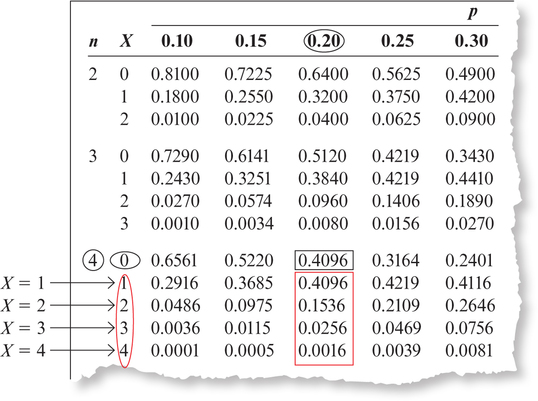
- In this case, “at least 1” means 1 or 2 or 3 or 4. So, by the Addition Rule for Mutually Exclusive Events, find the probabilities for X=1, X=2, X=3, and X=4, and add them up. Using the same column with column head 0.20 in the table as in part (a), we add up the four probabilities.
P(X≥1)=P(X=1)+P(X=2)+P(X=3)+P(X=4) =0.4096+0.1536+0.0256+0.0016=0.5904
This is the same answer we calculated in Example 16(b), but it is arrived at in a different way.
Next, a word about cumulative probability. Cumulative probability refers to the probability of, at most, a particular value of X. For example, what is the probability that, at most, X=2 Americans are sleep-deprived? This is the cumulative probability that X=0, X=1, or X=2. Statistical software and the TI-83/84 graphing calculator each have a function that will find cumulative binomial probabilities for you.
EXAMPLE 18Using technology to find binomial probabilities
Using the binomial distribution from Example 16, use the TI-83/84 and CrunchIt! to find the following probabilities:
- P(X=4), the probability that all four Americans are sleep-deprived.
- P(X≤2), the (cumulative) probability that, at most, two Americans are sleep-deprived.
Solution
We use the instructions in the Step-by-Step Technology Guide at the end of this section (page 336).
- Figure 9 shows that we use the TI-83/84 function binompdf with n=4, p=0.2, and X=4. Figure 10 shows the result: P(X=4)=0.0016. Figure 11 shows the same input and final answer using CrunchIt!.
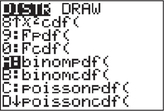 FIGURE 9 TI-83/84 menu.
FIGURE 9 TI-83/84 menu.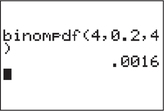 FIGURE 10 TI-83/84 result.
FIGURE 10 TI-83/84 result.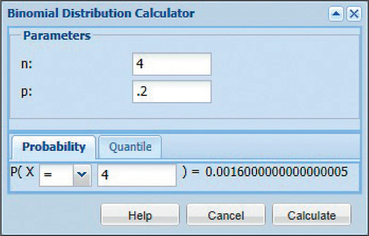 FIGURE 11 CrunchIt!
FIGURE 11 CrunchIt! - With the TI-83/84, we use the function binomcdf with n=4, p=0.2, and X=2. Figure 12 shows the result: P(X≤2)=0.9728. Figure 13 shows the input and final answer using CrunchIt!.
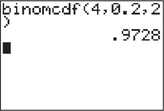 FIGURE 12 TI-83/84 result.
FIGURE 12 TI-83/84 result.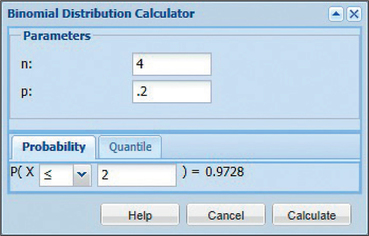 FIGURE 13 CrunchIt!
FIGURE 13 CrunchIt!
NOW YOU CAN DO
Exercises 29–48.
YOUR TURN#9
For a binomial experiment with n=10 and p=0.5, use the binomial tables or technology to calculate the following probabilities:
- P(X≤5)
- P(X<6)
- P(0≤X≤5)
- P(0<X<5)
(The solutions are shown in Appendix A.)
3Binomial Mean, Variance, Standard Deviation, and Mode
In Section 6.1, we examined the mean, variance, and standard deviation of a discrete random variable. The binomial random variable X is discrete, so it also has a mean, variance, and standard deviation, which are shown here.
Mean, Variance, and Standard Deviation of a Binomial Random Variable X
- Mean (or expected value): μ=η⋅p
- Variance: σ2=η⋅p⋅q
- Standard deviation: σ=√η⋅p⋅q
 These formulas work only for a binomial random variable.
These formulas work only for a binomial random variable.
EXAMPLE 19Binomial mean, variance, and standard deviation

 SAT Scores and AP Exam Scores
SAT Scores and AP Exam Scores
The College Board reports (2014) that 90% of students taking the Natural Sciences Subject SAT exam have taken high school chemistry. Suppose we take a sample of 100 students.
- Find the mean or expected number of Natural Sciences exam takers who have taken a chemistry course.
- Calculate the variance σ2 and standard deviation σ of the number of Natural Sciences exam takers who have taken a chemistry course.
- In our sample of 100, would it be unusual to observe 80 Natural Sciences exam takers who have taken a chemistry course?
Solution
The binomial random variable here is X = the number of Natural Sciences SAT exam takers who have taken a chemistry course, with sample size , probability of success , and probability failure .
- The mean or expected number who have taken a chemistry course is .
- , expressed in “students squared.” Then .
We use the -score method (Section 6.1, page 320) to determine whether would be unusual. The -score for 80 is:
According to the -score method of identifying outliers, Natural Sciences SAT exam takers having taken a chemistry course would be unusual because it is an outlier, with .
NOW YOU CAN DO
Exercises 49–52.
YOUR TURN#10
For a binomial experiment with and , answer the following:
- Find the mean .
- Calculate the variance and standard deviation .
- In a sample of 50, would it be unusual to observe ? (The solutions are shown in Appendix A.)
What Do and Mean?
The value is the “long-run” mean, and the value is the “long-run” standard deviation. That is, if we repeat this experiment an infinite number of times, identify the number of Natural Sciences SAT exam takers who took a chemistry course in each sample, and take the mean and standard deviation of each of these samples, they will equal and .
Next, we consider the mode of a binomial distribution.
The mode of a binomial distribution is the most likely outcome of the binomial experiment for the given values of and , that is, the outcome with the largest probability.
The next example shows how to find the mode for a binomial distribution.
EXAMPLE 20The binomial mode: the most likely outcome of a binomial experiment
Sixty percent of American adults use their cell phones to access the Internet, according to a 2013 report by the Pew Research Center. Suppose we take a random sample of American adults.
- Calculate the mean number of American adults who use their cell phones to access the Internet.
- Use the binomial table to construct a probability distribution graph of the random variable X = the number of Americans who use their cell phones to access the Internet.
- Use the binomial table or the probability distribution graph to find the most likely number of American adults who use their cell phones to access the Internet. Note that this represents the mode of the distribution.
Solution
- Figure 14 is an excerpt from the binomial table, highlighting the probabilities for , for and . We use these probabilities to construct the probability distribution graph shown in Figure 15.Page 336
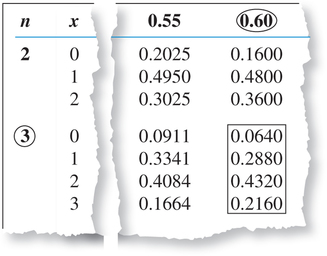 FIGURE 14 Probabilities for .
FIGURE 14 Probabilities for .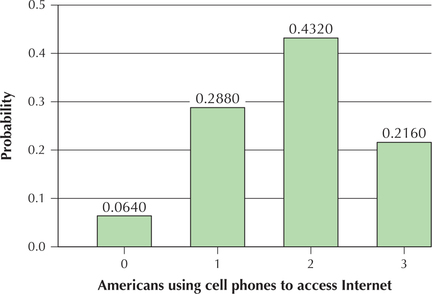 FIGURE 15 Probability distribution graph of .
FIGURE 15 Probability distribution graph of . - The most likely number of Americans using their cell phones to access the Internet is associated with the largest probability in the boxed section of Figure 14, 0.4320, which is . Note from Figure 15 that has the tallest bar of probability. Thus, is the most likely number of American adults using their cell phones to access the Internet. We say that is the mode of the distribution of .
NOW YOU CAN DO
Exercises 53–56.